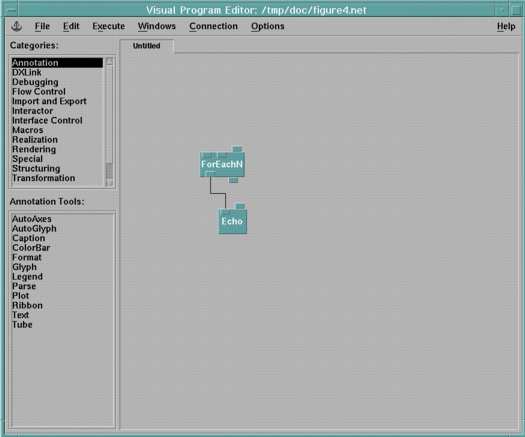The sequencer provides a basic loop; however it has some limitations. Only one sequencer per visual program is allowed, and, as it executes, everything in the visual program executes (subject to the optimization for deciding which modules need to be executed, discussed above). Additional functionality is provided using the ForEachN, ForEachMember, Done, and First modules.
ForEachN and ForEachMember essentially implement a standard programming-language "for" loop; in the case of ForEachN iterating over a specified list of integers, and in the case of ForEachMember iterating over the members in a group or the items in a list (or array). Figure 21 shows a simple loop that outputs the integers 0 to 10 and Echo's them (the start and end parameters to ForEachN have been set to 0 and 10 respectively). This is roughly equivalent to the C-language statements
for (i=0; i<=10; i++)
printf("%d", i);

Data Explorer provides you with two other tools for control looping, Done and First. Done enables you to exit a loop. Examples of its use can be found in "Advanced Loop Constructs" (see below). The First module provides a way to recognize the first pass through a loop; this is particularly useful, for example, as a way to reset the GetGlobal module if you are using GetGlobal and SetGlobal (see below) to store information during the execution of a loop. Note that First is not necessary if you are using GetLocal and SetLocal.
When a loop is present in a visual program, it causes the execution of all modules in the visual program containing the looping tool (ForEachN, ForEachMember, or Done), subject to optimization. For this reason it is strongly suggested that looping modules NOT be placed in the top level visual program, but rather be used only within macros. If used within a macro, the macro will not output any values until the loop is complete, when the ForEachN or ForEachMember list is exhausted or when the Done module causes an exit.
If a loop occurs inside a macro, and you reexecute a visual program calling this macro, the loop will not be reexecuted as long as the result of the macro remains in the cache. However, the presence of a side effect module (such as WriteImage or Print) inside of a loop will cause the loop to be reexecuted regardless of whether the output of the macro remains in the cache. If this is not the desired behavior, Route can be used to turn off the entire macro.
For efficiency you might find it desirable to set the caching option to Last Result for modules within the loop. In this way, multiple intermediate values within a loop will not use up valuable cache space.
Note that the full execution of a loop is considered to occur within a single execution of the graph (as would occur if you select Execute Once from the Execute menu). Thus if you change any interactor values DURING the execution of the loop, those interactor values will not take effect until the loop is complete. This is an important way in which looping differs from using the Sequencer; if you change the value of an interactor while the Sequencer is running, the value will be updated on the next frame of the sequence.
[ OpenDX Home at IBM | OpenDX.org ]